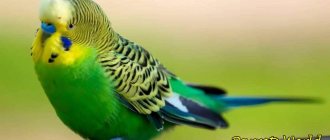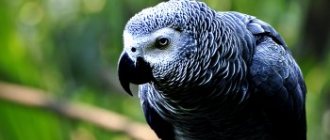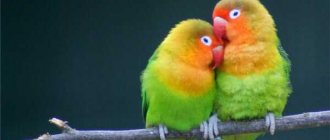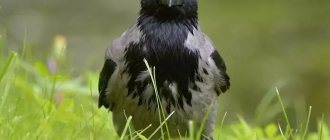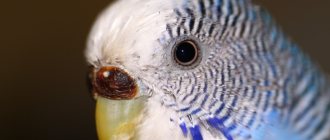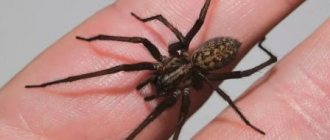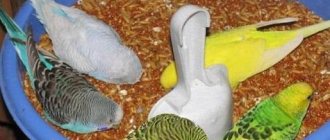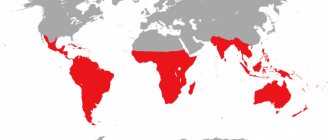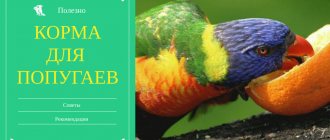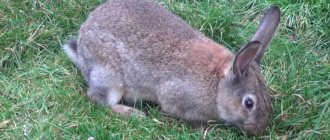Budgerigars are the birds that breeders love to work with. Counting the exact number of budgerigar species is incredibly difficult. There are many colors, shapes and colors of plumage. There are 32 primary mutations and more than a hundred secondary ones. Today we will talk about the most common breeds of wavy cats, and also look at several unusual colors.
Clear-winged parrot and lutino
Blue
First of all, it must be said that, surprisingly, the color diversity of budgies is a man-made phenomenon.
Important! There is only one color of budgerigar in the wild, and that is light green. Moreover, in fact, the bird’s plumage contains yellow and black colors, but an optical illusion makes us see this combination as green (our eye perceives black as blue, and yellow plus blue, as is known, produces green). All other colors of “wavy” are mutations skillfully used by humans.
As a result, today blue parrots can be found, perhaps, even more often than green ones. They are welcoming and friendly creatures, and considering that the bluebird is a symbol of good luck, it is not surprising that this color is so popular among bird lovers.
Blue budgerigars were bred in France at the beginning of the twentieth century, although 25 years earlier Belgian breeders had already encountered similar mutations in the birds' colors.
Character and behavior
Birds of this species are particularly active and love to talk. The trills emitted by one wavy will inform all its neighbors about its existence. The birds are especially noisy at dawn and sunset. It would be a good idea to cover the cage with a thick cloth so that the parrot thinks it’s night and doesn’t make any noise. Otherwise, the bird may make loud noises
On the one hand, the loud sounds made by a budgie greatly disturb the owners, on the other hand, this is why they are loved. And if you teach your feathered pet human words, you can get a pleasant interlocutor.
Birds love attention and constantly want to communicate with people; they quickly become loyal pets and close friends with their owner. All that pets ask in return is a sufficient amount of attention and proper care for the pet.
Teaching human speech to a wavy is quite simple. It is necessary for the bird to trust its owner. Males and chicks under six months of age are especially amenable to training. After this, the likelihood that the owner will be able to teach the budgerigar human speech begins to decrease.
Usually the first word is the proper name. The owner needs to constantly train his ward, up to half an hour every day is enough. For the success of the bird, it is necessary to reward it with “yummy food”. Thus, after a short period of time you can get a pleasant interlocutor.
Greens
It is not surprising that this color is the standard for an exotic bird. In the wild, budgerigars live in Australia, which is known as the green continent. No other colors will give small, defenseless birds a more reliable chance to get lost in the abundant tropical greenery and not become an accidental victim of a predator, and parrots have quite a lot of natural enemies, and they are quite dangerous.
A parrot has practically no chance of escaping from a kite or falcon, so the best way to protect itself is to remain unnoticed.
Did you know? Surprisingly, such a small bird as a budgerigar can cover a distance of one hundred kilometers in search of water, only stopping once for a three-hour rest.
Light green
The main color of the "natural" budgerigar's plumage is that of young glossy grass, darker on the back and lighter green on the underparts, chest and belly. The bird has a light yellow mask on its head, six black spots on its throat plus two purple spots on the sides of its cheekbones. The entire back from the head itself and the wings are decorated with a motley black pattern in the form of wavy lines (hence the name of the bird). A special highlight is the dark blue central feathers on the wings and tail with a metallic tint. Sometimes the tail feathers are blue, and the flight feathers are black or dark green. The paws are greenish-gray.
However, as a result of domestication and long-term selection, a huge number of different types of shades of green budgies have been bred, bearing little resemblance to their original colors.
Natural color
The natural color of the budgie is green, matching the color of grass and foliage. Nature designed it this way for birds to camouflage themselves from their enemies. But this idea was doomed to failure - parrots spend most of their lives in huge flocks that are impossible not to notice.
The main feature from which the wavy is named is black waves covering the back from the back of the head and wings. The bulk of the feathers are brighter or paler, there are spots and patterns. Light green feathers cover the bird's body, with the exception of the top of the back. Light yellow face mask, several black oval spots near the throat, cheeks marked with purple. The tail is blue, with yellow and green feathers at the edges. The wings are dark, the edges of the feathers are edged with yellow.
The female and male are colored the same, and the chicks look like their parents. Deviations occur when a chick appears in the nest, strikingly different from its flock mates. This is due to a malfunction in the set of transferred genes. A parrot with a wonderful color is most often doomed to death: it is more difficult for such an individual to escape from a predator, and in the flock it is mistaken for a stranger and killed. Through natural selection, nature leaves only the fittest birds.
yellowface
A yellow “face” is a natural feature for a budgerigar, but blue birds with a yellow head are usually called yellow-faced, or simply yellow-faced. If the natural color of a bird, as we said, contains yellow and black colors, which amazingly give the illusion of green, then in order for yellow to become the main color, it is enough to simply remove the black pigment from the color. However, many breeders believe that yellow-faced parrots are not green birds without yellow, but blue birds with yellow, and discussions on this matter continue to this day.
There are three main types of yellow-faced budgies: type 1 and type 2, as well as the golden-faced, sometimes called the Australian.
Did you know? Another amazing feature of budgerigars is the ability to quickly restore the population and find an opportunity to survive in unfavorable conditions. Thus, during a period of severe drought in Australia, which lasted three years, 62 thousand birds were found dead from thirst near one dried-up reservoir. But when the rains finally began in certain areas, it took the “wavy birds” only two weeks to completely settle in a new place, covering huge areas with their nests!
European with normal pattern
This type of color has been known for more than 135 years. The bird has blue plumage throughout its body and its head is a pale lemon color. In the first type, the yellow color is practically absent from the body or occurs in the form of small, almost imperceptible streaks, sometimes visible in the feathers of the wings and tail. A separate variety is a bird with a very light yellow mask that looks almost white.
The second type of yellow-faced parrots is characterized by the presence of a lemon tint throughout the body, wings and tail. The main color of the feathers is at first bright azure, but during the molting process it increasingly approaches green. In this same variety, there may be an uneven proportion in the distribution of yellow and blue, resulting in the underparts of the bird appearing blue and the breast aqua green.
Familiarize yourself with the peculiarities of keeping such birds as: goldfinch, siskin, crossbill, canary, and black crow.
Australian normal
While European yellowfaces are characterized by shades similar to lemon, Australians associate it more with egg yolk. It is this tone that replaces white throughout the plumage: it is present on the flight feathers, in the tail, and on the body, as a result of which the bird looks green. As with European yellowfaces, in this case it is also possible to have a variation of uneven coloring of yellow and blue, as a result of which the lower part of the parrot is blue, and the upper part of the body is green.
In fact, the Australian coloration (golden-faced birds) is something intermediate between blue and green, and therefore this color is called “parblue” (partial blue), however, sometimes this term is also used in relation to European yellowfaces.
The difference between GDP and a regular “wave”
The most important difference from other wavy representatives is the presence of a lush cap of feathers, which often looks like a real crown, and a beard of feathers under the beak. The hat can be small, very neat, it happens that it is no longer a hat, but a kind of punkish high crest, standing straight up in one clear bush; There are Czechs with a huge feather cap, which is larger than their head and can even hang over their eyes.
The feather beard of classic-colored Czechs is entirely covered along the lower edge as if with beads; this pattern consists of feathers of a darker, often black color.
Simple wavy beads also have such spots, but ordinary wavy beads have only a few of them, most often six, while Czech beads can have a row of beads ranging from several large ones to dozens of small clusters.
There is an opinion that it is much easier to teach a Czech to speak than the rest of his relatives. Indeed, some representatives of this species begin to speak on their own, absolutely without training.
Gray
Adding a gray factor allows you to get several shades of gray. Depending on what color the bird is taken as the basis for breeding (green or blue), we get gray or gray-green individuals.
Important! Regardless of the color of your pets, you can cross them with each other, thus joining in the exciting breeding work. Nevertheless, in order for it to be successful, it is still better to study the basics of the genetics of “wavy animals”. If you don’t want to experiment, you can follow one basic rule: when crossing individuals of the same genotype, the offspring will have the same color, but the colors of the chicks will be much brighter than those of the parents.
Gray (also called dominant or Australian grey) budgies can come in a variety of shades, but one of the rarest and most beautiful colors in this series is anthracite. The plumage of this bird is so dark that it appears black, sometimes with white splashes.
This coloring owes its appearance to German breeders, although in fairness it must be said that back in the 30s of the last century, gray parrots of a very dark shade were bred in England, however, unfortunately, this variety was not preserved (mainly due to the fact that that the dark gray color acted as a recessive factor in the genotype and was thus lost when crossed with any other individual).
How to tame a budgie?
If you constantly communicate with the bird, it will quickly get used to the person. Handing over a favorite treat and talking affectionately is the most important thing at the first stage of adaptation.
The bird must be treated with treats through the bars so as not to scare it away. The hand with the treat can then be moved into the open door. When your pet confidently takes food, you can offer him a finger instead of a perch. While walking around the room, they offer a treat so that the bird can fly or reach its owner on its own. You can’t run after her, you can’t catch her, trust must come gradually.
Budgerigar - All about the breed | Parrot breed - Wavy
Gray-green
Gray-green budgies come in a variety of shades , from lighter to darker (brown).
Due to its close proximity to the natural color, this color was bred in the homeland of the “wavy”, in Australia. This happened in 1935. The birds have a mustard tint to the main plumage, the mask is a standard yellow color, and the black spots on the throat add a gray tint. The wavy stripes along the body are black and very contrasting, the flight feathers are green or black, and the tail is black.
Learn more about the feeding habits of parrots, as well as how to prolong their life at home and improve relationships.
Maintenance, care, feeding at home
The food is based on grain mixtures, which you can make yourself or buy ready-made. These are flax, sesame, sunflower, oats, canary seed and the like. In winter they feed sprouted wheat.
Budgerigar - Interesting facts about the bird species
In our climate, it is necessary to maintain the required air temperature and humidity (+22-25, 55-70%, respectively). To prevent overheating, you need a bath and a humidifier. Be sure to regulate daylight hours. It should be as close in duration as possible to the Australian one (12 hours in winter, 14 in summer). The cage and accessories are spilled with boiling water before the bird is introduced. The tray is cleaned daily. General cleaning is carried out once a week. The parrot must fly, so it is let out of its cage every day for at least an hour. You can also buy a home that is so spacious that there will be no lack of movement.
Gray-blue
The result of the work of French breeders is gray-blue budgies. Interestingly, this color scheme is one of the oldest; it was established back in 1924. These birds differ from ordinary gray ones in that the main color of the front and rear lower parts of their body is distinctly blue with a pinkish or purple tint. The mask on the head is not yellow, but white, the black waves and dots are the same as those of blue parrots, and the tail is dark blue.
Mauve
Perhaps this is one of the most beautiful colors of a budgie. The bird looks surprisingly gentle and harmonious. Despite the fact that at first glance it appears to be light gray, in fact there is no gray tint in the plumage. Almost the entire body is evenly painted with a delicate mauve color without any streaks or inclusions. Under the beak there is a white mask with black dots, above the beak up to the forehead there is also a white area, turning into a series of black transverse stripes on the back of the head. There should be no other color splashes or patterns on the head.
Habitat, habitat in the wild
A variety of birds of this species have settled throughout almost all of Australia, except for deserts. They live in Tasmania, on many large and small islands located nearby.
BREEDING BUDGETS || PROS AND CONS OF BREEDING
Usually the flock wanders from place to place in search of food, preferring open forests, steppe zones and semi-deserts. These are the places that are located on the east and west coasts, in the center of the mainland. Only in the north in dense forests is life impossible for them.
Purple
The owner of a purple budgerigar can cause no less envy among neighbors. German breeders managed to obtain this color in the late 20s of the last century. It is based on the gray gene, which is dominant. Variations in plumage shades are also possible here - from purple as such to the delicate color of Persian lilac (the presence of a dark or blue factor, as well as the amount of purple - single or double) plays a decisive role.
According to approved standards, there are three shades of purple in the colors of budgies , although in reality there are at least six times more!
Nutrition
The basis of the wavy's diet is grain. Special grain mixtures can be purchased in stores or prepared independently.
It is best to use the following cereals:
- Millet.
- Corn.
- Oats.
- Sesame.
It would be a good idea to add the following treats to your pet’s diet:
- Vegetables. Suitable carrots, cabbage, cucumbers, tomatoes.
- Citrus fruits, pears and apples, bananas, and kiwi are ideal fruits.
- From berries you can choose strawberries, raspberries, rowan or blackberries.
- Various greens that can be purchased at any grocery store.
